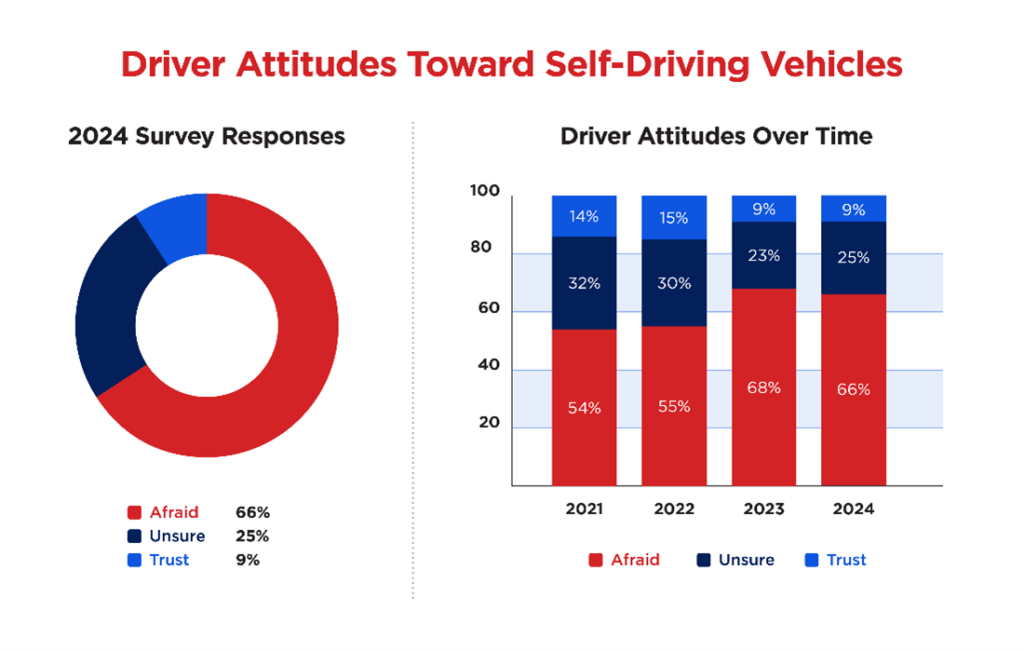BOISE – Someday, autonomous vehicles (AVs) may offer mobility solutions for many people, including those hindered by limitations in the current technology. But for now, most Americans view the prospect of a vehicle driving itself with a high degree of skepticism.
According to AAA research, nine in ten U.S. drivers would be afraid (66%) or uncertain (25%) about riding in a self-driving car, the same percentage as a year ago. The number of drivers specifically expressing fear jumped from 55% in 2022 to 68% in 2023, dipping slightly this year.

“Recently, there have been several well-publicized incidents where AV technology has fallen short, and that naturally makes some people leery about turning over complete control to the system,” says AAA Idaho public affairs director Matthew Conde. “An incremental rollout of proven technologies will be key to getting drivers more comfortable with the idea of a fully self-driving car. States like Idaho will also require significant mapping and broadband to support the technology.”
While autonomous vehicles are not currently available for purchase, nearly one in ten drivers believe they can already buy a car that will drive itself while they sleep.
“In the Advanced Driver Assistance Systems, or ADAS, space, knowledge gaps are extremely dangerous,” Conde said. “We’ve got to ensure that everyone understands what today’s leading-edge technology can and cannot do, including in the rural areas that abound in the Gem State.”
While the concept of full autonomy is a major concern to most drivers, six in ten say they would “definitely” or “probably” want some type of advanced safety features in their next vehicle:
- Automatic Emergency Braking – 63%
- Reverse Automatic Emergency Braking – 62%
- Lane Keeping Assistance – 58%
- Adaptive Cruise Control – 55%
- Active Driving Assistance – 46%
Previous AAA research demonstrates that these technologies, while helpful, do not prevent a crash in every instance. Road safety remains highly dependent on attentive human drivers.
Based on the names automakers use for ADAS, such as Autopilot, ProPilot, and Pilot Assist, 22% of survey respondents expect the system to drive by itself without any supervision, a misconception that puts themselves and other road users at risk. AAA urges vehicle manufacturers to help clear up the confusion by naming technology in a way that more accurately reflects performance.
Attitudes about AV technology also vary by generation. Millennials (60%) are less likely to be afraid of riding in a self-driving vehicle than Baby Boomers (77%), but they are also more likely to incorrectly believe that they can now purchase a vehicle that will drive itself while they sleep.
“As a reminder, the ‘assist’ in Advanced Driver Assistance Systems is there for a reason. Truly autonomous vehicle robotaxi fleets are only operational in a few geo-fenced areas in a handful of cities nationwide, and no one can or should delegate the entire driving task to any car that’s available for purchase today,” Conde said. “In our automotive research, no ADAS technology has avoided a crash on every test run.”
AAA urges drivers to do research before they buy a new or used vehicle to have a complete understanding of system capabilities and limitations. Vehicle manufacturers and legislators should ensure that any rollout of new technologies meets the highest standards for safety.
Conde related his own experience with AV technology. “A couple of years ago in Arizona, I hailed a ride using an AV company’s app, and an empty vehicle arrived right in front of me in the grocery store parking lot,” he said. “At first, it felt strange to sit in the back of the car with a plexiglass divider between me and the front of the vehicle, watching the steering wheel move without human assistance. But it flawlessly executed the route I’d selected, using LIDAR, RADAR, and cameras to “see” our surroundings and city streets with amazing clarity and detail.
In my line of work, I’ve had the opportunity to learn about AV technology for many years, and that gave me more confidence to begin with. Like so many new things, as drivers receive education and exposure to a consistently safe technology over time, fear and uncertainty will likely subside.”

